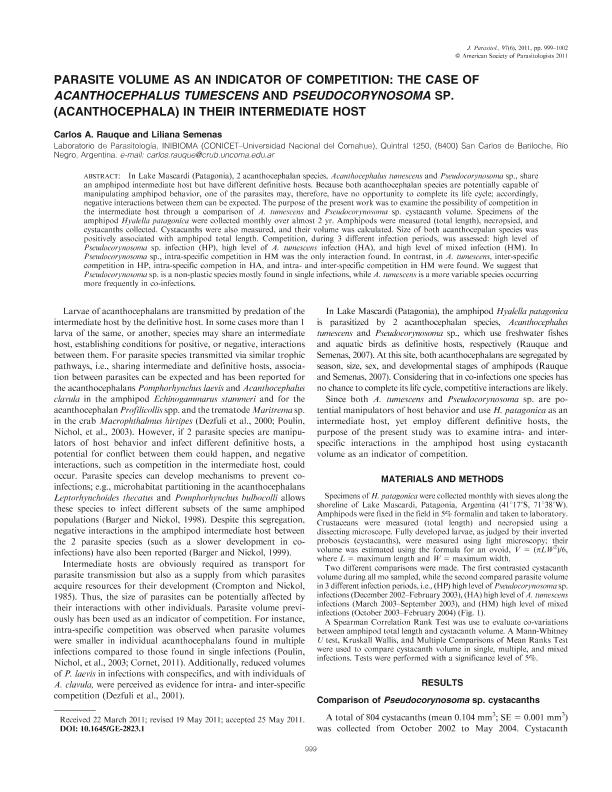Mostrar el registro sencillo del ítem
dc.contributor.author
Rauque Perez, Carlos Alejandro

dc.contributor.author
Semenas, Liliana Graciela

dc.date.available
2019-05-20T18:15:44Z
dc.date.issued
2011-12-01
dc.identifier.citation
Rauque Perez, Carlos Alejandro; Semenas, Liliana Graciela; Parasite volume as an indicator of competition: The case of Acanthocephalus tumescens and Pseudocorynosoma SP. (Acanthocephala) in their intermediate host; American Society of Parasitologists; Journal of Parasitology; 97; 6; 1-12-2011; 999-1002
dc.identifier.issn
0022-3395
dc.identifier.uri
http://hdl.handle.net/11336/76724
dc.description.abstract
In Lake Mascardi (Patagonia), 2 acanthocephalan species, Acanthocephalus tumescens and Pseudocorynosoma sp., share an amphipod intermediate host but have different definitive hosts. Because both acanthocephalan species are potentially capable of manipulating amphipod behavior, one of the parasites may, therefore, have no opportunity to complete its life cycle; accordingly, negative interactions between them can be expected. The purpose of the present work was to examine the possibility of competition in the intermediate host through a comparison of A. tumescens and Pseudocorynosoma sp. cystacanth volume. Specimens of the amphipod Hyalella patagonica were collected monthly over almost 2 yr. Amphipods were measured (total length), necropsied, and cystacanths collected. Cystacanths were also measured, and their volume was calculated. Size of both acanthocepalan species was positively associated with amphipod total length. Competition, during 3 different infection periods, was assessed: high level of Pseudocorynosoma sp. infection (HP), high level of A. tumescens infection (HA), and high level of mixed infection (HM). In Pseudocorynosoma sp., intra-specific competition in HM was the only interaction found. In contrast, in A. tumescens, inter-specific competition in HP, intra-specific competion in HA, and intra- and inter-specific competition in HM were found. We suggest that Pseudocorynosoma sp. is a non-plastic species mostly found in single infections, while A. tumescens is a more variable species occurring more frequently in co-infections.
dc.format
application/pdf
dc.language.iso
eng
dc.publisher
American Society of Parasitologists

dc.rights
info:eu-repo/semantics/openAccess
dc.rights.uri
https://creativecommons.org/licenses/by-nc-sa/2.5/ar/
dc.subject
Acanthocephalus Tumescens
dc.subject
Pseudocorynosoma Sp.
dc.subject
Parasites
dc.subject
Amphipods
dc.subject.classification
Otras Ciencias Biológicas

dc.subject.classification
Ciencias Biológicas

dc.subject.classification
CIENCIAS NATURALES Y EXACTAS

dc.title
Parasite volume as an indicator of competition: The case of Acanthocephalus tumescens and Pseudocorynosoma SP. (Acanthocephala) in their intermediate host
dc.type
info:eu-repo/semantics/article
dc.type
info:ar-repo/semantics/artículo
dc.type
info:eu-repo/semantics/publishedVersion
dc.date.updated
2019-04-23T15:05:21Z
dc.journal.volume
97
dc.journal.number
6
dc.journal.pagination
999-1002
dc.journal.pais
Estados Unidos

dc.journal.ciudad
Washington DC
dc.description.fil
Fil: Rauque Perez, Carlos Alejandro. Consejo Nacional de Investigaciones Científicas y Técnicas. Centro Científico Tecnológico Conicet - Patagonia Norte. Instituto de Investigaciones en Biodiversidad y Medioambiente. Universidad Nacional del Comahue. Centro Regional Universidad Bariloche. Instituto de Investigaciones en Biodiversidad y Medioambiente; Argentina
dc.description.fil
Fil: Semenas, Liliana Graciela. Universidad Nacional del Comahue. Centro Regional Universitario Bariloche; Argentina
dc.journal.title
Journal of Parasitology

dc.relation.alternativeid
info:eu-repo/semantics/altIdentifier/doi/http://dx.doi.org/10.1645/GE-2823.1
dc.relation.alternativeid
info:eu-repo/semantics/altIdentifier/url/https://bioone.org/journals/journal-of-parasitology/volume-97/issue-6/GE-2823.1/Parasite-Volume-As-An-Indicator-of-Competition--The-Case/10.1645/GE-2823.1.short
Archivos asociados
